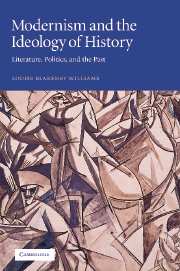Book contents
- Frontmatter
- Contents
- Acknowledgements
- Abbreviations
- Introduction
- 1 “Immaterial pleasure houses”: the initial aesthetic dilemma
- 2 “A more dream-heavy hour”: medievalist and progressive beginnings
- 3 “Pedantry and hysteria”: contemporary political problems
- 4 “A certain discipline”: radical conservative solutions
- 5 “A particularly lively wheel”: cyclic views emerge
- 6 “Our own image”: the example of Asian and non-Western cultures
- 7 In “the grip of the … vortex”: the proof of Post-Impressionist art
- 8 The “cycle dance”: cyclic history arrives
- 9 “The Nightmare” and beyond: the First World War and mature cyclic theories
- Conclusion
- Notes
- Index
9 - “The Nightmare” and beyond: the First World War and mature cyclic theories
Published online by Cambridge University Press: 22 September 2009
- Frontmatter
- Contents
- Acknowledgements
- Abbreviations
- Introduction
- 1 “Immaterial pleasure houses”: the initial aesthetic dilemma
- 2 “A more dream-heavy hour”: medievalist and progressive beginnings
- 3 “Pedantry and hysteria”: contemporary political problems
- 4 “A certain discipline”: radical conservative solutions
- 5 “A particularly lively wheel”: cyclic views emerge
- 6 “Our own image”: the example of Asian and non-Western cultures
- 7 In “the grip of the … vortex”: the proof of Post-Impressionist art
- 8 The “cycle dance”: cyclic history arrives
- 9 “The Nightmare” and beyond: the First World War and mature cyclic theories
- Conclusion
- Notes
- Index
Summary
Such a war-time that let loose the foulest feelings of a mob … to torture any single, independent man as a mob always tortures the isolated and independent.
D.H. Lawrence, Kangaroo, 1923.On August 4, 1914 what D.H. Lawrence later described as “The Nightmare” began. Being part of the “aristocracy of the arts” did not protect the five Modernists from the life-changing and often devastating events of the First World War. This does not mean that they all lived through it in the same ways. In fact, like the population of Britain in general, their experiences of, and reactions to, the war varied greatly. The most tragic case was that of T.E. Hulme. Immediately after the declaration of war Hulme enlisted. He fought at the front from late 1914 to September 1917, with an interval of a few months in 1915 when he was recovering from wounds. Hulme was killed on September 28, 1917. According to an obituary in The Cambridge Magazine, “the shell which is supposed to have blown him to pieces burst unobserved, and its explosion left no trace of his remains.”
Ford's war also was dominated by active military service, but with less devastating results. He enlisted in the army in July 1915, fought at the Somme in the summer of 1916 and was hospitalized for illnesses caused by shell-shock and gas.
- Type
- Chapter
- Information
- Modernism and the Ideology of HistoryLiterature, Politics, and the Past, pp. 184 - 205Publisher: Cambridge University PressPrint publication year: 2002



